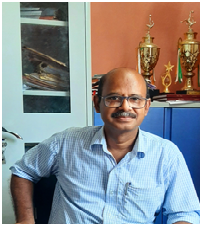
Academic record & distinction
M.Sc: Kanpur University, India
PhD: H.N.B. Garhwal University, India
Awards/ Distinctions received:
- Recipient of the second O-CHA (tea) Pioneer Academic Research Grant 2002-2003, from the “Secretariat of the World Green Tea Association”,Shizuoka Prefecture Government, Shizuoka, Japan.
- SERC Fast Track Young Scientist 2001-2002 award of the Department of Science and Technology, Govt. of India.
- Recipient of National Scholarship (1982-1984), Ministry of Education and Culture, Govt. of India, during Higher Secondary (H.S.).
Areas of Specialization:
Plant Tissue Culture, Plant cell & protoplast culture, Commercial Micro-propagation & Crop improvement.
Research Guidance:
PhD Research: 02 awarded, 01 submitted, 04 registered
M.Sc. Desertion: 12 awarded, 02 registered
Number of Publications & Projects:
Publications in Research Journals: 32; Books: 03; Book chapters: 10; Popular articles: 01; Research projects: Completed 11, Ongoing 02.
Latest Publications
- Bamaniya B.S., Das T., Sherpa T.L., Tare K., Rana M. and Bag N. (2024) Bacterial wilt caused by Ralstonia solanacearum: A potential threat to brinjal cultivated in Sikkim, India. Natl. Acad. Sci. Lett. ttps://doi.org/10.1007/s40009-024-01449-6 (IF: 1.2)
- Sherpa M.T., Sharma L., Bag N. and Das S. (2021) Isolation, Characterization, and Evaluation of Native Rhizobacterial Consortia Developed From the Rhizosphere of Rice Grown in Organic State Sikkim, India, and Their Effect on Plant Growth. Frontiers in Microbiology 12: 1-15. https://doi.org/10.3389/fmicb.2021.713660 (IF: 4.0)
- Sherpa MT, Bag N, Das S, Haokip P and Sharma L (2021) Isolation and characterization of plant growth promoting rhizobacteria isolated from organically grown high yielding pole type native pea (Pisum sativum L.) variety Dentami of Sikkim, India. Current Research in Microbial Sciences 2: 1-11. https://doi.org/10.1016/j.crmicr.2021.100068 (IF: 4.8)
- Gurung K., Dasila K., Pandey A. and Bag N. (2020) Curvularia eragrostidis – a new threat to Large Cardamom (Amomum subulatum Roxb.) causing leaf blight in Sikkim, J Biosci (2020) 45:113 (DOI: 10.1007/s12038-020-00086-7), (IF: 2.795).
- Rai O., Rana M. and Bag N. (2020) Micropropagation of Bird of Paradise (Strelitzia reginae Ait.). Natl. Acad. Sci. Lett. (https://doi.org/10.1007/s40009-020-01023-w), (IF: 1.2).
- Bag N., Palni LMS and Nandi SK (2019) An efficient method for acclimatization: In vitro hardening of tissue culture raised tea plants [Camellia sinensis (L.) O. Kuntze], Current Science 117(2): 288-293. (IF: 1.102)
- Bag A. and Bag N. (2019) Antimetastatic Properties of Tea Polyphenols, Nutrition and Cancer, pp. 1-12, https://doi.org/10.1080/01635581.2019.1638426 (IF: 2.32)
- Bag N., Chandra S., Palni L.M.S. and Nandi S.K. (2000) Micrpropropagation of Dev-ringal (Thamnocalamus spathiflorus [(Trin.) Munro] - a temperate bamboo, and comparison of in vitro propagated plants and seedlings. Plant Sci. 156: 125-135; (IF: 4.2).
- Pandey A., Palni L.M.S. and Bag N. (2000) Biological hardening of tissue culture raised tea plants through rhizosphere bacteria. Biotech. Letters 22: 1087-1091; (IF: 2.716).
- Bag N. and Palni L.M.S. (2010) A two-step and highly reproducible procedure for in vitro rooting of micropropagated tea [Camellia sinensis L. (O) Kuntze] shoots. J. Hort. Sci. & Biotech: 85 (3) 197–204; (IF: 1.641).
- Bag N., Palni L.M.S., Chandra S. and Nandi S.K. (2012) Somatic embryogenesis in ‘Maggar’ bamboo (Dendrocalamus hamiltonii) and field performance of regenerated plants. Curr. Sci. 102(9): 1279-1287; (IF: 1.102).
- Begum F., Paul S., Bag N., Sikder S.R. and Sen S.K. (1995) Somatic hybrids between Brassica juncea (L). Czern and Deplotaxis hara (Forsk.) Boiss and the generation of backcross progenies. Theor. Appl. Genet. 91: 1167-1172; (IF: 5.45).
- Bag A. and BagN. (2008) Target Sequence Polymorphism of Human Manganese Superoxide Dismutase Gene and Its Association with Cancer Risk: A Review. Cancer Epidemiology, Biomarkers & Prevention 17(12): 3298-3305; (IF: 5.057).
- Bag N., Palni L.M.S. and Nandi S.K. (1997) Mass propagation of tea using tissue culture methods. Physiol. Mol. Biol. Plants 3: 99-103; (IF: 3.023).
- Joshi S.C., Bag N., Palni L.M.S., Bisht M.S. and Vyas P. (2000) Use of CO2 uptake and chlorophyll fluorescence for the early selection of tea clones: an assessment. J. Plant Biol. 27(3): 247-252; (IF: 3.150).
